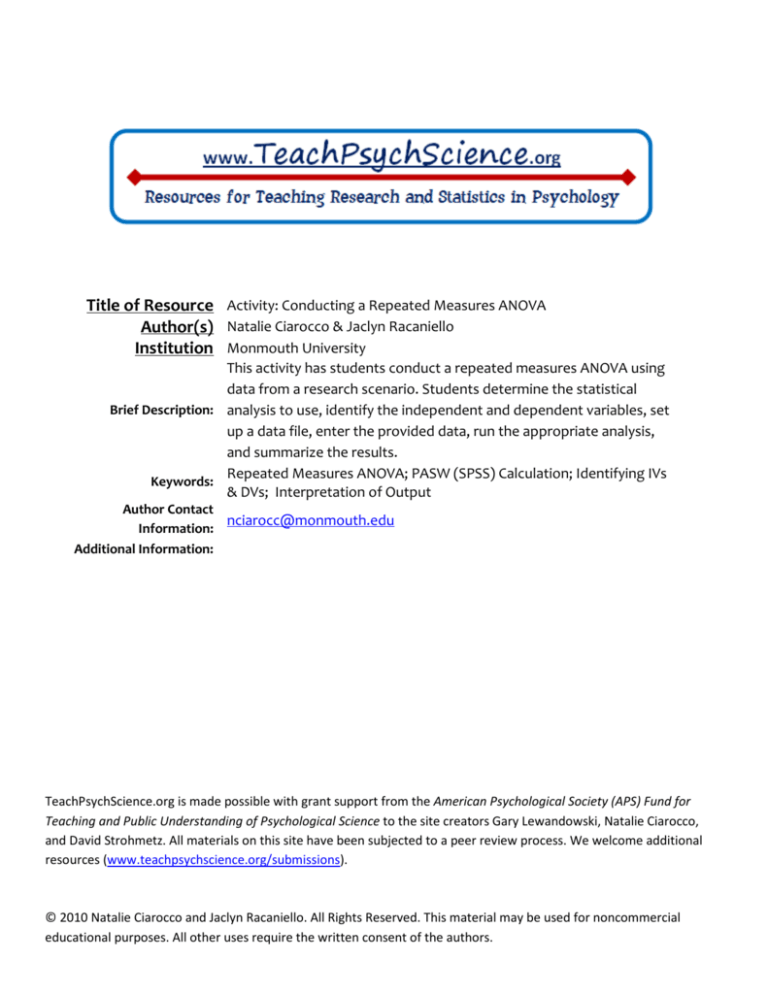
Title of Resource Activity: Conducting a Repeated Measures ANOVA
Author(s) Natalie Ciarocco & Jaclyn Racaniello
Institution Monmouth University
This activity has students conduct a repeated measures ANOVA using
data from a research scenario. Students determine the statistical
Brief Description: analysis to use, identify the independent and dependent variables, set
up a data file, enter the provided data, run the appropriate analysis,
and summarize the results.
Repeated Measures ANOVA; PASW (SPSS) Calculation; Identifying IVs
Keywords:
& DVs; Interpretation of Output
Author Contact
nciarocc@monmouth.edu
Information:
Additional Information:
TeachPsychScience.org is made possible with grant support from the American Psychological Society (APS) Fund for
Teaching and Public Understanding of Psychological Science to the site creators Gary Lewandowski, Natalie Ciarocco,
and David Strohmetz. All materials on this site have been subjected to a peer review process. We welcome additional
resources (www.teachpsychscience.org/submissions).
© 2010 Natalie Ciarocco and Jaclyn Racaniello. All Rights Reserved. This material may be used for noncommercial
educational purposes. All other uses require the written consent of the authors.
Instructors:
In this activity, students will take data from a fictitious design to practice conducting a repeated measures
ANOVA. First, provide students with the research scenario and the accompanying questions to have them
determine the research design, statistical analysis to use, and independent and dependent variables. Next,
have students set up a data file using the included data from the study and run the appropriate analysis.
Students should summarize their results. An answer key and output are included. Although PASW (SPSS)
output is provided, this activity could be run using any statistics program or students could perform
calculations by hand.
Research Scenario
A researcher is interested in testing which brand of coffee tastes better. Ten people were selected to participate
in tasting four different types of coffee: Maxwell House, Folgers, Starbucks, and Dunkin Donuts. All coffee
brands were made by the researcher from fresh grinds and the order in which each participant tasted the coffees
was counterbalanced. After tasting each brand of coffee, participants rated the quality of taste on a 7-point scale
(1 = terrible to 7 = delicious). It is hypothesized that the brands will differ in quality of taste.
1. What type of methodological design is being utilized?
2. What statistical analysis should be utilized to test the prediction?
3. Identify the independent variable(s):
4. Identify the dependent variable(s):
5. Set up an appropriate data file and enter the provided data.
6. Run the appropriate analysis and summarize your findings below:
_____
______
Participant #: 1
Age: ,;{S
~e mCl
Gender:
Ie..
Dunkin Donuts score out of7: L\
Folgers score out of7:
1
\
Starbucks score out of 7:
Maxwell score out of7:
S
- - - - - - - - - - - - - - - - - - - - - - - - - - - - - - - - - - - - - - - - - - - - - - - - - - - - - - - - - - - - --
Participant #: 2
Age: ~ 1
Gender: rn C/k:
Dunkin Donuts score out of 7: L1
Folgers score out of7: lo
Starbucks score out of7:.J
Maxwell score out of 7: \.p
- - - - - - - - - - - - - - - - - - - - - -- - - - - - - - - - - - - - - - - - - - - - - -- - --- - -- - - - - - - --
Participant #: 3
Age:
36
Gender:
~malt'
Dunkin Donuts score out of 7:Lj
Folgers score out of7: (p
Starbucks score out of 7: I
Maxwell score out of7: (Q
- - - - - - - - - - - - - - - - - - - -- - - - - - - - - - - - - - - - - - - - - - - - - - - - - - - - - - - - - - - - --
Participant #: 4
Age: ;<0,
Gender: +cmo k:
Dunkin Donuts score out of 7: S
Folgers score out of7: lP
Starbucks score out of7:
3
Maxwell score out of 7: 5
- - - - - - - - - - - - - - - - - - - - - - - - - - - - - - - - - - - - - - - -- - - - - - -- - - - - - - - - - - - - -Participant #: 5
Age:
\~
Gender: ~mo. \.e
Dunkin Donuts score out of 7:
(p
Folgers score out of7: ':)
Starbucks score out of7: L-I
Maxwell score out of7: 1-)
- - - - - -- - - - - - - - - - - - - - - -- - - - - - - - - - - - - - - - - - - - - - - - - - - - - - -- - - - - - - --
Participant #: 6
Age: 31
Gender:
pi
u\e
Dunkin Donuts score out of7:
S
Folgers score out of7: ~
Starbucks score out of7: \
Maxwell score out of 7: 4
- - - - - - - - - - - - - - - -- - - - - - - - - -- - - - - - - - - - - - - - - - - - - - - - - - - - - - - - - - - - --
Participant #: 7
Age: L\0
Gender: ~e /YO Ie
/
Dunkin Donuts score out of 7: ;)
Folgers score out of7: -,
Starbucks score out of7: JMaxwell score out of 7:
Lv
- - - - - - - - - - - - - - - - - - - - - -- - - - - - - - - - - - - - - - - - - - - - - - - - - - - - - - - -- - - - -Participant #: 8
Age:
S\
Gender:
)'YIQ \e.
Dunkin Donuts score out of7:
3
Folgers score out of7: I
Starbucks score out of7: :;l.
Maxwell score out of 7: c:)
- - - - - - - - - - - - - - - -- - - - - - - - - - - - -- - - - - - - - - - - - - - - - - - - - - - - - - - -- - - - -Participant #: 9
Age: L\d
c YnCt l-e
Gender: +'
Dunkin Donuts score out of 7:
Folgers score out of 7:
~
{p
Starbucks score out of7: J
Maxwell score out of 7: S
- - - - - - - - - - - - - - - - - - - - - - - - - - - - - - - - -- - - - - - - - - - - - - - - - - - - - - - - - -- - --
Participant #: 10
Age: (06
Gender: n1C\ 1<:
Dunkin Donuts score out of7:
F olgers score out of 7: 1.0
Starbucks score out of7:
L\
Maxwell score out of7: Y
5
ANSWER KEY
Conducting a One-way ANOVA
Research Scenario
A researcher is interested in testing which brand of coffee tastes better. Ten people were selected to participate
in tasting four different types of coffee: Maxwell House, Folgers, Starbucks, and Dunkin Donuts. All coffee
brands were made by the researcher from fresh grinds and the order in which each participant tasted the coffees
was counterbalanced. After tasting each brand of coffee, participants rated the quality of taste on a 7-point scale
(1 = terrible to 7 = delicious). It is hypothesized that the brands will differ in quality of taste.
1. What type of methodological design is being utilized?
multi-group design (repeated measures)
2. What statistical analysis should be utilized to test the prediction?
3. Identify the independent variable(s):
Repeated Measures ANOVA
brand of coffee
4. Identify the levels of each independent variable: Maxwell House, Folgers, Starbucks, and Dunkin Donuts
5. Identify the dependent variables:
quality of taste (range 1-7)
6. Set up an appropriate data file and enter the provided data.
7. Run the appropriate analysis and summarize your findings below:
The hypothesis was supported. The quality of taste was rated as significantly different between brands.
Pairwise comparisons revealed that the ratings of Folgers (M = 6.20) coffee were significantly higher
than the ratings of Maxwell House (M = 5.00) , Starbucks (M = 2.30), and Dunkin Donuts (M = 4.20).
Similarly, Starbucks was rated significantly lower than each of the other brands.
PASW (SPSS) Output
Conducting a Repeated Measures ANOVA
General Linear Model
Within-Subjects
Factors
Descriptive Statistics
Measure:MEASURE_1
coffee_1
Mean
Dependent Variable
Std. Deviation
1
Dunkin_Donuts
Dunkin_Donuts
4.2000
2
Folgers
Folgers
3
Starbucks
Starbucks
Maxwell
Maxwell
4
N
1.13529
10
6.2000
.63246
10
2.3000
1.15950
10
5.0000
.81650
10
Multivariate Testsb
Effect
coffee_1
Value
F
Hypothesis df
a
Error df
Sig.
Pillai's Trace
.904
21.953
3.000
7.000
.001
Wilks' Lambda
.096
21.953a
3.000
7.000
.001
9.409
a
3.000
7.000
.001
a
3.000
7.000
.001
Hotelling's Trace
Roy's Largest Root
21.953
9.409
21.953
a. Exact statistic
b. Design: Intercept
Within Subjects Design: coffee_1
Mauchly's Test of Sphericityb
Measure:MEASURE_1
Within
Subjects
Effect
coffee_1
Epsilona
Mauchly's W
.348
Approx. Chi-Square
8.151
df
GreenhouseGeisser
Sig.
5
.151
.609
Huynh-Feldt
Lower-bound
.756
Tests the null hypothesis that the error covariance matrix of the orthonormalized transformed dependent variables is proportional to an identity
matrix.
a. May be used to adjust the degrees of freedom for the averaged tests of significance. Corrected tests are displayed in the Tests of WithinSubjects Effects table.
b. Design: Intercept
Within Subjects Design: coffee_1
.333
Tests of Within-Subjects Effects
Measure:MEASURE_1
Type III Sum of
Squares
Source
coffee_1
Error(coffee_1)
df
Mean Square
F
Sphericity Assumed
80.475
3
26.825
23.535
.000
Greenhouse-Geisser
80.475
1.827
44.048
23.535
.000
Huynh-Feldt
80.475
2.268
35.480
23.535
.000
Lower-bound
80.475
1.000
80.475
23.535
.001
Sphericity Assumed
30.775
27
1.140
Greenhouse-Geisser
30.775
16.443
1.872
Huynh-Feldt
30.775
20.414
1.508
Lower-bound
30.775
9.000
3.419
Tests of Within-Subjects Contrasts
Measure:MEASURE_1
Type III Sum of
Squares
Source
coffee_1
coffee_1
Linear
1.125
1
1.125
1.074
.327
Quadratic
1.225
1
1.225
2.436
.153
Cubic
78.125
1
78.125
41.790
.000
Linear
9.425
9
1.047
Quadratic
4.525
9
.503
16.825
9
1.869
Error(coffee_1)
Cubic
df
Mean Square
F
Tests of Between-Subjects Effects
Measure:MEASURE_1
Transformed Variable:Average
Type III Sum of
Squares
Source
Intercept
df
Mean Square
783.225
1
783.225
2.525
9
.281
Error
Estimated Marginal Means
1. Grand Mean
Measure:MEASURE_1
95% Confidence Interval
Mean
4.425
Sig.
Std. Error
.084
Lower Bound
4.236
Upper Bound
4.614
F
2791.693
Sig.
.000
Sig.
2. coffee_1
Estimates
Measure:MEASURE_1
95% Confidence Interval
coffee_1
Mean
Std. Error
Lower Bound
Upper Bound
1
4.200
.359
3.388
5.012
2
6.200
.200
5.748
6.652
3
2.300
.367
1.471
3.129
4
5.000
.258
4.416
5.584
Pairwise Comparisons
Measure:MEASURE_1
(I)
(J)
coffee_1 coffee_1
1
3
4
Sig.a
Std. Error
Lower Bound
Upper Bound
*
.537
.005
-3.216
-.784
*
1.900
.379
.001
1.044
2.756
4
-.800
.573
.196
-2.097
.497
1
2.000*
.537
.005
.784
3.216
3
3.900*
.504
.000
2.759
5.041
4
*
1.200
.249
.001
.636
1.764
1
-1.900*
.379
.001
-2.756
-1.044
2
-3.900*
.504
.000
-5.041
-2.759
4
*
-2.700
.539
.001
-3.918
-1.482
1
.800
.573
.196
-.497
2.097
2
*
.249
.001
-1.764
-.636
*
.539
.001
1.482
3.918
2
-2.000
3
2
95% Confidence Interval for Differencea
Mean Difference (IJ)
-1.200
3
2.700
Based on estimated marginal means
*. The mean difference is significant at the .05 level.
a. Adjustment for multiple comparisons: Least Significant Difference (equivalent to no adjustments).
Multivariate Tests
Value
Pillai's trace
Wilks' lambda
.904
F
Hypothesis df
Error df
Sig.
a
3.000
7.000
.001
a
21.953
.096
21.953
3.000
7.000
.001
Hotelling's trace
9.409
21.953a
3.000
7.000
.001
Roy's largest root
9.409
21.953a
3.000
7.000
.001
Each F tests the multivariate effect of coffee_1. These tests are based on the linearly independent
pairwise comparisons among the estimated marginal means.
a. Exact statistic



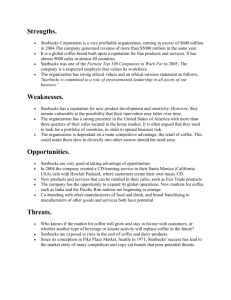
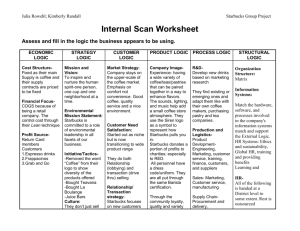
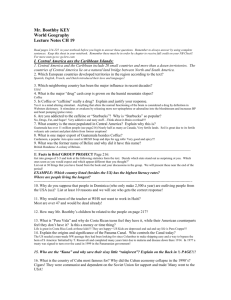
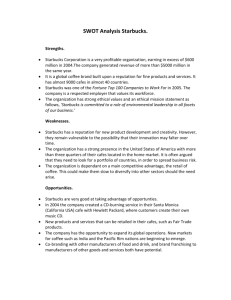
![저기요[jeo-gi-yo] - WordPress.com](http://s2.studylib.net/store/data/005572742_1-676dcc06fe6d6aaa8f3ba5da35df9fe7-300x300.png)
